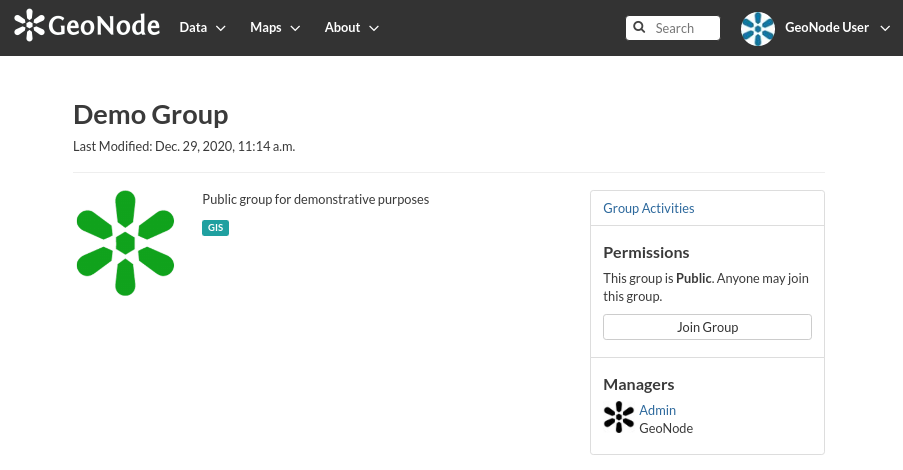
User Groups in GeoNode
“User groups allow actions like publishing and permissions management to be applied to multiple users at once”
GeoNode has a wide range of actions and tools available, so performing actions with granular controls on an individual basis would become tedious very quickly. To improve usability of action management, GeoNode provides user "Groups", which are collections of user accounts which can be used for the application.
User groups function in a similar manner to user profiles, in that they can be used for a variety of functions including:
- The publication and sharing of content, tracking of content changes and notifications etc.
- The control of content permissions and actions
- The curation, cataloging and discovery of content
GeoNode provides multiple group types, which include the following:
- Public: Public groups are visible to all users, and registered users can join or invite other users to the group without the need of a group manager invitation. These are particularly useful for content curation and monitoring updates to specific content
- Public (Invite-Only): Public groups are visible to all users, but registered users cannot join the group without being explicitly invited by a group manager. This group type is useful for access control and can be used in a variety of contexts, for example by sharing specific content with only a select number of users or limiting content downloads or metadata editing to invited users only
- Private: Private groups are hidden from view unless a registered user account has been explicitly invited to the group. These groups are useful for managing access control for sensitive content or data, or for restricting certain actions such as content editing permissions to selected users
Viewing of groups will also show the user accounts that are members or managers, allowing registered users to contact group managers to request inclusion in the group.

You try:
Goal: To create and understand GeoNode user group types and functions
- Navigate to the Groups section on the About menu from the GeoNode interface and review the available groups
- Try to search and filter the groups by name and category
- Find a public group to join and join that group
- Upload new content, or modify the permissions for existing content to include your new group with elevated permissions, such as metadata editing
- Try to share some private content with a specific group
- Try to add content to a Group by editing the content metadata
- Review the group content and try to find out how curated content collections are possible with GeoNode groups
- Review some invite-only groups and identify group members and managers, as well as how to contact them for access to the group content
Check your results
Did you manage to join a public group? What new features and content discovery mechanisms did you discover?
Have you joined multiple groups and reviewed your new options by attempting searches or reviewing your activity feed?
Did you find out how to contact group administrators to request access to a restricted group?
Did you manage to get promoted to a group manager? What controls became available that aren't available to group members?


More about User Groups
By default, Groups must be created by a user with Administrative privileges on the GeoNode system. Once a group is created, however, the members of a group can be split into group members and group managers. Group members are simply user accounts that inherit permissions and actions from the group, whereas group managers are users which can edit the group object details, such as description and keywords, or add and remove other members from private or invite-only groups.
Group categories are static definitions which are used for cataloging and filtering groups, however it should be noted that these categories can only be edited by system administrators, and unless by explicit design they do not indicate the group type or permission level. GeoNode groups can fortunately be tagged with multiple category types to assist with group management.

Check your knowledge:
-
Can any registered user create a user group on GeoNode:
- No, only system administrators can create new user groups
- Yes, users can create any type of group so long as they are using a registered user account
- Yes, registered users can create public groups, but only administrators can create private groups
-
Which of the following statements is not true of GeoNode user groups:
- Groups can be used to control content permissions for multiple user accounts at once
- Groups contain controls to prevent other platform users from sending them messages
- Groups can be used to monitor activity on platform content assigned to the group

